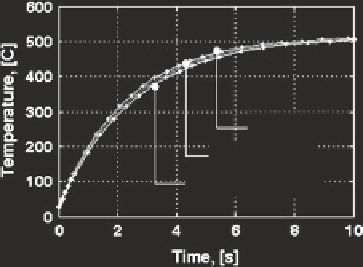Civil Engineering Reference
In-Depth Information
Fig. 5.17
Specific heat
sensitivity (SS304) [
11
].
Thermal profiles of stationary
electrical tests with specific
heat values for particular
temperatures
Conv. (30
o
C)
EAF (250
o
C)
Stationary (500
o
C)
value as the temperature increased. In this case, the Ti-G5 material had a slightly
steeper specific heat versus temperature relationship, and the maximum temper-
ature reached during the Ti-G5 testing was about twice the temperature reached
during the SS304 testing. In summary, the specific heat of the material needs to
be considered when modeling EAF. It is highly dependent on the temperature
range reached during forming (between room temperature and the hottest electri-
cal temperature). As the specific heat increases, the energy required to increase the
temperature of the workpiece also increases, and this can lead to an overall lower
thermal profile. This is shown in Figs.
5.16
and
5.17
, where the thermal profiles
using the highest specific heat values are the lowest.
5.4 Heat Transfer Modes Analysis
As electrical power is input into a system, as in the EAM technique, some level
of heating will take place. To this extent, heat will be lost by way of the three heat
transfer modes (conduction, convection, and radiation). The temperature increase
of the workpiece can be represented by Eq. (
5.23
):
E
part
=
E
g
−
E
out
,
Q
=
Q
e
−
Q
cond
−
Q
conv
−
Q
rad
,
(5.23)
Q
,
E
g
is
where
E
part
is the rate of change of the energy content in the part analyzed
, and
E
out
is the rate
of energy leaving the part due to the sum of conduction into the dies in the contact zone
(
Q
cond
), convection (
Q
conv
), and radiation from the surface (
Q
rad
). To clarify,
E
g
has only
one contributor (
Q
e
), whereas
E
out
has three contributors (
Q
cond
,
Q
conv
,
Q
rad
) that are the
three forms of heat transfer. The energy is the total amount of heat lost or gained, and
the power is the rate of heat lost or gained over time. Using constitutive equations for
each component, the heat equation that determines the temperature rise for particular
electric parameters is shown in Eq. (
5.24
):
Q
e
the rate of heat generation due to the electric resistive heating

